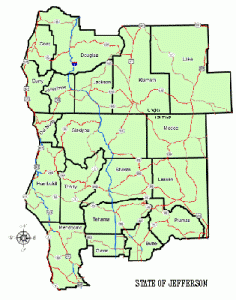Welcome to Our Historic Jefferson Backroads Website containing all of Our Beloved Happy Little Publications. We ran Jefferson Backroads and delivered them to our readers monthly in both paper and electronic formats, from April 2010 through March 2020.
Producing 120 happy little publications sure taught us a lot about the magazine world and we were blessed to work with MANY AMAZING Mom & Pop Businesses throughout the Western USA!! We used the proposed historic State of Jefferson boundary maps including the counties in Extreme Southern Oregon and Northern California which we found in old historic writings for our distribution … and then we cruised up and down all the 2 lane highway backroads every month for ten years gathering and delivering the many interesting pieces of history we could get our hands on. We combined the fascinating history of all these badass communities with the modern day features and events taking place in our own magical piece of Rural Small Town America and Bamm!! Jefferson Backroads Publication was born!!
Just go to our Back Issues Page which is arranged in order by year and month. By clicking on the thumbnail of each of our 120 + monthly publications in pdf format, you can enjoy reading through all the incredible stories and articles written and shared by some of the most lovely local historic authors we could find.
You can also find a few of our favorite businesses, local publications, wineries and breweries still operating in Our State of Jefferson Region by looking at our other pages on our website.
Thank You for taking the time to find us!
Michelle Fain,
Editor/Publisher
Jefferson Backroads Publication
———————————————————-
HISTORY OF THE STATE OF JEFFERSON
written by Gail Jenner
Today’s State of Jefferson refers to portions of Southern Oregon and Northern California. Originally this region represented the “second half” or “northern mines” of the famous gold rush of 1849-50, but it never received the kind of historical reference that the Sierra Mother Lode did, even though it contributed as much, if not more, to the coffers of the two states. Moreover, the region was easily overlooked after the gold rush, since it continued to be less populated and more rural than the remainder of the two states.
Because the people who have settled along the northern boundary of California and the southern boundary of Oregon have always been of an independent nature, it seems fitting that this region has attempted, on numerous occasions, to create a new state, not just in name or principle, but in reality as well.
The principle is not a new one, however, but has its roots in the area’s history. In 1852, a bill to create a new state died in committee. On December 19, 1853, THE DAILY ALTA OF CALIFORNIA of San Francisco suggested that Northern California and Southern Oregon could both benefit if a ‘new state’ could be created. Some suggested it be called ‘Klamath.’ Others suggested the name “Jackson.”
At a meeting held on January 7, 1854, in Jacksonville, Oregon, Lafayette F. Mosher spoke about a state of ‘Jackson.’ Unfortunately, as the son-in-law of General Lane, with well-known pro-slavery and anti-Indian beliefs, the proposed state’s identity was tainted by prejudice and unfounded fear.
In 1854-55, the State Assembly tried to split California into three states: “Shasta” to the north, “Colorado” in the middle, and “California” to the south. But the Senate let the bill lapse. In 1877-78, some again pushed for “Shasta” in the north, but the U. S. Congress vetoed the proposal.
By the fall of 1941, most communities in and around the region were behind the idea of secession. In a contest held by the Siskiyou Daily News, the name “State of Jefferson” was officially born. Several Oregon and California counties joined in.
In order to garner attention, a protest was staged along Highway 99 near Yreka. Members of Yreka’s 20-30 Club stopped cars and passed out a declaration and pledged to secede every Thursday until the State of Jefferson became recognized as a state.
The movement gained momentum and Stanton Delaplane won the Pulitzer Prize writing about the conditions leading up to Jefferson State’s “official” secession. A gubernatorial race was held, complete with a parade and speeches and even a dancing bear, but then, on December 7th, 1941, the bombing of Pearl Harbor took precedence over the region’s rebellion.
Even today, the dream lives on for this unrealized, some might even say, mystical State of Jefferson. With majestic Mt. Shasta at its heart, and the Cascades forming its backbone, the region’s wild rivers and rugged peaks both isolate and, at times, insulate its residents from the more populated outside world. Ranching, mining and logging have been its traditional source of wealth, but now recreation and tourism compete as major industries. But it’s the people who reside here that make the greatest contribution to the character of the region.
Please click on our Publication Tab and select Back Issues to read any of our 120+ publications of our happy little monthly Jefferson Backroads Publications.
